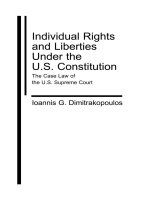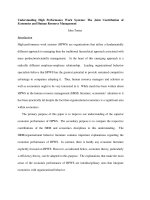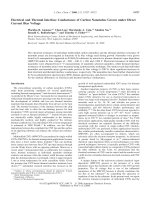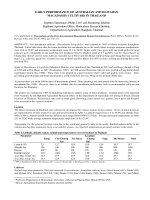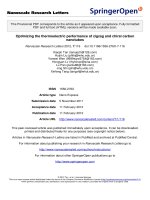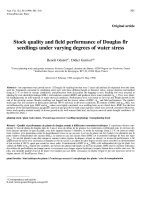Dynamic performance of bridges and vehicles under strong wind
Bạn đang xem bản rút gọn của tài liệu. Xem và tải ngay bản đầy đủ của tài liệu tại đây (4.41 MB, 208 trang )
DYNAMIC PERFORMANCE OF BRIDGES AND VEHICLES
UNDER STRONG WIND
A Dissertation
Submitted to the Graduate Faculty of the
Louisiana State University and
Agricultural and Mechanical College
in partial fulfillment of the
requirements for the degree of
Doctor of Philosophy
in
The Department of Civil and Environmental Engineering
By
Suren Chen
B.S., Tongji University, 1994
M.S., Tongji University, 1997
May 2004
DEDICATION
To my parents, my wife and my son
ii
ACKNOWLEDGMENTS
I am indebted to Professor Steve Cai, my advisor, for his active mentorship, constant
encouragement, and support during my Ph. D study at LSU and KSU. It has been my greatest
pleasure to work with such a brilliant, considerate and friendly scholar.
I also want to express my sincere gratitude to Professor Christopher J. Baker of The
University of Birmingham. The advice obtained from him on the vehicle accident assessment
was very helpful and encouraging. The advice and help given by Dr. John D. Holmes on the
time-history simulations are particularly appreciated. I also want to thank Professor Marc L.
Levitan, the director of the Hurricane Center at LSU, for his very helpful courses on hurricane
engineering and his great work as a member of my committee. Gratitude is also extended to
Professor M. Gu at Tongji University and Professor C. C. Chang at Hong Kong University of
Science and Technology for their continuous encouragement and support.
Thanks are also extended to my other committee members: Professor Dimitris E.
Nikitopoulos of Mechanical Engineering, Professor Jannette Frandsen of Civil Engineering, and
Professor Jaye E. Cable of Oceanography & Coastal Sciences for very helpful suggestions in the
dissertation.
The Graduate Assistantship offered by Louisiana State University and the National Science
Foundation (NSF) made it possible for me to proceed with my study.
Last but not the least, I would like to thank my beloved wife and my son for their strong
support. The dissertation could not have been completed without their encouragement, their love
and their patience.
iii
TABLE OF CONTENTS
DEDICATION ii
ACKNOWLEDGMENTS iii
ABSTRACT vi
CHAPTER 1.INTRODUCTION 1
1.1 Wind Hazard 1
1.2 Bridge Aerodynamics 3
1.3 Vehicle Dynamic Performance on the Bridge under Wind 5
1.4 Structural Control on Wind-induced Vibration of Bridges 7
1.5 Present Research 8
CHAPTER 2. MODAL COUPLING ASSESSMENTS AND APPROXIMATED PREDICTION
OF COUPLED MULTIMODE WIND VIBRATION OF LONG-SPAN BRIDGES 10
2.1 Introduction 10
2.2 Mathematical Formulations 11
2.3 Approximated Prediction of Coupled Buffeting Response 18
2.4 Numerical Example 19
2.5 Concluding Remarks 31
CHAPTER 3. EVOLUTION OF LONG-SPAN BRIDGE RESPONSE TO WIND-
NUMERICAL SIMULATION AND DISCUSSION 33
3.1 Introduction 33
3.2 Motivation of Present Research 33
3.3 Analytical Approach 34
3.4 Numerical Procedure 38
3.5 Numerical Example 40
3.6 Concluding Remarks 56
CHAPTER 4. DYNAMIC ANALYSIS OF VEHICLE-BRIDGE-WIND DYNAMIC
SYSTEM . 58
4.1 Introduction 58
4.2 Equations of Motion for 3-D Vehicle-Bridge-Wind System 59
4.3 Dynamic Analysis of Vehicle-Bridge System under Strong Wind 68
4.4 Numerical Example 70
4.5 Concluding Remarks 93
4.6 Matrix Details of the Coupled System………………………………………………… 94
CHAPTER 5. ACCIDENT ASSESSMENT OF VEHICLES ON LONG-SPAN BRIDGES IN
WINDY ENVIRONMENTS 101
5.1 Introduction 101
5.2 Dynamic Interaction of Non-Articulated Vehicles on Bridges 102
iv
5.3 Accident Analysis Model for Vehicles on Bridges 105
5.4 Numerical Example 113
5.5 Concluding Remarks 129
CHAPTER 6. STRONG WIND-INDUCED COUPLED VIBRATION AND CONTROL WITH
TUNED MASS DAMPER FOR LONG-SPAN BRIDGES. 131
6.1 Introduction 131
6.2 Closed-Form Solution of Bridge-TMD System 132
6.3 Coupled Vibration Control with a Typical 2DOF Model .138
6.4 Analysis of a Prototype Bridge 143
6.5 Concluding Remarks 154
CHAPTER 7. OPTIMAL VARIABLES OF TMDS FOR MULTI-MODE BUFFETING
CONTROL OF LONG-SPAN BRDGES 156
7.1 Introduction 156
7.2 Formulations of Multi-mode Coupled Vibration Control with TMDs 157
7.3 Parametrical Studies on “Three-row” TMD Control 161
7.4 Concluding Remarks 177
CHAPTER 8. WIND VIBRATION MITIGATION OF LONG-SPAN BRIDGES IN
HURRICANES 178
8.1 Introduction 178
8.2 Equations of Motion of Bridge-SDS System 179
8.3 Solution of Flutter and Buffeting Response 181
8.4 Numerical Example: Humen Bridge-SDS system 182
8.5 Concluding Remarks 187
CHAPTER 9. CONCLUSIONS AND FURTHER CONSIDERATIONS 189
9.1 Summary and Conclusions 189
9.2 Future Work 191
REFERENCES…………………………………………………………………………………193
VITA……… 201
v
vi
ABSTRACT
The record of span length for flexible bridges has been broken with the development of
modern materials and construction techniques. With the increase of bridge span, the dynamic
response of the bridge becomes more significant under external wind action and traffic loads.
The present research targets specifically on dynamic performance of bridges as well as the
transportation under strong wind.
The dissertation studied the coupled vibration features of bridges under strong wind. The
current research proposed the modal coupling assessment technique for bridges. A closed-form
spectral solution and a practical methodology are provided to predict coupled multimode
vibration without actually solving the coupled equations. The modal coupling effect was then
quantified using a so-called modal coupling factor (MCF). Based on the modal coupling analysis
techniques, the mechanism of transition from multi-frequency type of buffeting to single-
frequency type of flutter was numerically demonstrated. As a result, the transition phenomena
observed from wind tunnel tests can be better understood and some confusing concepts in flutter
vibrations are clarified.
The framework of vehicle-bridge-wind interaction analysis model was then built. With the
interaction model, the dynamic performance of vehicles and bridges under wind and road
roughness input can be assessed for different vehicle numbers and different vehicle types. Based
on interaction analysis results, the framework of vehicle accident analysis model was introduced.
As a result, the safer vehicle transportation under wind can be expected and the service
capabilities of those transportation infrastructures can be maximized. Such result is especially
important for evacuation planning to potentially save lives during evacuation in hurricane-prone
area.
The dissertation finally studied how to improve the dynamic performance of bridges under
wind. The special features of structural control with Tuned Mass Dampers (TMD) on the
buffeting response under strong wind were studied. It was found that TMD can also be very
efficient when wind speed is high through attenuating modal coupling effects among modes. A
3-row TMD control strategy and a moveable control strategy under hurricane conditions were
then proposed to achieve better control performance.
CHAPTER 1. INTRODUCTION
The dissertation is made up of nine chapters based on papers that have either been
accepted, or are under review, or are to be submitted to peer-reviewed journals, using the
technical paper format that is approved by the Graduate School.
Chapter 1 introduces the related background knowledge of the dissertation, the research
scope and structure of the dissertation. Chapter 2 discusses the modal coupling effect on bridge
aerodynamic performances (Chen et al. 2004). Chapter 3 covers the evolution of the long-span
bridge response to the wind (Chen and Cai 2003a). Chapter 4 discusses the dynamic analysis of
the vehicles-bridge-wind system (Cai and Chen 2004a). Chapter 5 discusses the vehicle safety
assessment of vehicles on long-span bridges under wind (Chen and Cai 2004a). Chapter 6
investigates the new features of strong-wind induced vibration control with Tuned Mass
Dampers on long-span bridges (Chen and Cai 2004b). Chapter 7 studies the optimal variables of
Tuned Mass Dampers on multiple-mode buffeting control (Chen et al. 2003). Chapter 8
investigates the wind vibration mitigation on long-span bridges in hurricane conditions (Cai and
Chen 2004b). Chapter 9 summarizes the dissertation and gives some suggestions for future
research.
This introductory chapter gives a general background related to the present research. More
detailed information can be seen in each individual chapter.
1.1
Wind Hazard
Wind is about air movement relative to the earth, driven by different forces caused by
pressure differences of the atmosphere, by different solar heating on the earth’s surface, and by
the rotation of the earth. It is also possible for local severe winds to be originated from local
convective effects and the uplift of air masses. Wind loading competes with seismic loading as
the dominant environmental loading for modern structures. Compared with earthquakes, wind
loading produces roughly equal amounts of damage over a long time period (Holmes, 2001). The
major wind storms are usually classified as follows:
Tropical cyclones: Tropical cyclones belong to intense cyclonic storms which usually
occur over the tropical oceans. Driven by the latent heat of the oceans, tropical cyclones
usually will not form within about 5 degrees of the Equator. Tropical cyclones are called in
different names around the world. They are named hurricanes in the Caribbean and
typhoons in the South China Sea and off the northwest coast of Australia (Holmes, 2001).
Thunderstorm: Thunderstorms are capable of generating severe winds, through tornadoes
and downbursts. They contribute significantly to the strong gusts recorded in many
countries, including the United States, Australia and South Africa. They are also the main
source of high winds in the equatorial regions (within about 10 degrees of the Equator),
although their strength is not high in these regions (Holmes, 2001; Simiu and Scanlan,
1986).
Tornadoes: These are larger and last longer than “ordinary” convection cells. The tornado,
a vertical, funnel-shaped vortex created in thunderclouds, is the most destructive of wind
storms. They are quite small in their horizontal extent-of the order of 100 m. However, they
1
can travel for quite a long distance, up to 50 km, before dissipating, producing a long
narrow path of destruction. They occur mainly in large continental plains, and they have
very rarely passed over a weather recording station because of their small size (Holmes,
2001).
Downbursts: Downbursts have a short duration and also a rapid change of wind direction
during their passage across the measurement station. The horizontal wind speed in a
thunderstorm downburst, with respect to the moving storm, is similar to that in a jet of fluid
impinging on a plain surface (Holmes, 2001).
Damage to buildings and other structures caused by wind storm has been a fact of life for
human beings since these structures appeared. In nineteenth century, steel and reinforcement
were introduced as construction materials. During the last two centuries, major structural failures
due to wind action have occurred periodically and provoked much interest in wind loadings by
engineers. Long-span bridges often produced the most spectacular of these failures, such as the
Brighton Chain Pier Bridge in England in 1836, the Tay Bridge in Scotland in 1879, and the
Tacoma Narrows Bridge in Washington State in 1940. Besides, other large structures have
experienced failures as well, such as the collapse of the Ferrybridge cooling tower in the U. K. in
1965, and the permanent deformation of the columns of the Great Plains Life Building in
Lubbock, Texas, during a tornado in 1970. Based on annual insured losses in billions of US
dollars from all major natural disasters, from 1970 to 1999, wind storms account for about 70%
of total insured losses (Holmes, 2001). This research addresses transportation-related issues due
to hurricane-induced winds.
Hurricanes and hurricane-induced strong wind are, by many measures, the most devastating
of all catastrophic natural hazards that affect the United States. The past two decades have
witnessed exponential growth in damage due to hurricanes, and the situation continues to
deteriorate. The most vulnerable areas, coastal countries along the Gulf and Atlantic seaboards,
are experiencing greater population growth and development than anywhere else in the country.
In the United States, annual monetary losses due to tropical cyclones and other natural hazards
have been increasing at an exponential pace, now averaging up to $1 billion a week (Mileti,
1999). Large hurricanes can have impacts that are national or even international in scope.
Damage from Hurricane Andrew was so extensive (total loss approximately $25 billion) that it
caused building materials shortages nationwide and bankrupted many Florida insurance
companies. Had Andrew’s track shifted just a few miles, it could have gone through downtown
Miami, hit Naples on the west coast of Florida, and then devastated New Orleans. Projections for
the total losses in this scenario are several times greater than the $25 billion in damages caused
by Andrew. Losses of this magnitude threaten the stability of national and international
reinsurance markets, with potentially global economic consequences. When a hurricane or
tropical storm does strike the gulf coast, the results are generally devastating.
In additional to huge loss of property, loss of life is even more stunning. Compared to the
U. S., developing countries which lack predicting and warning systems are suffering even more
from hurricane-associated hazards. The cyclone in October 1999 killed tens of thousands in
India, and Hurricane Mitch killed thousands in Honduras in 1998. Even as storm prediction and
tracking technologies improve, providing greater warning times, the U. S. is still becoming ever
more susceptible to the effects of hurricanes, due to the massive population growth in the South
and Southeast along the hurricane coast from Texas to Florida to the Carolinas. This growth has
2
spurred tremendous investments in areas of greatest risk. The transportation infrastructure has
not increased capacity at anything like a similar pace, necessitating longer lead times for
evacuations and forcing some communities to adopt a shelter-in-place concept. This concept
recognizes that it will not be possible for everyone to evacuate, so only those in areas of greatest
risk from storm-surge are given evacuation orders.
New Orleans is a typical example of the hurricane-prone cities in the United States. Due to
the fact that most of the city is at or below sea level, protected only by levees, it has been
estimated that a direct hit by a Category 3 or larger hurricane will “fill the bowl”, submerging
most of the city in 20 feet or more of water (Fischetti 2001). In extreme cases, evacuations are
essential to minimize the loss of lives and properties. In New Orleans, four of the five major
evacuation routes out of the city include highway bridges over open water. The Louisiana Office
of Emergency Preparedness estimates that under current conditions, there will be time to
evacuate only 60-65% of the 1.3 million Metro area populations in the best-case scenario, with a
10% casualty rate for those remaining in the city.
To ensure a successful evacuation, smooth transportation is the key to the whole evacuation
process. There are two categories of problems to be dealt with: the safety and efficient service of
the transportation infrastructures, such as bridges and highways; the safe operation of vehicles on
those transportation infrastructures (Baker 1994; Baker and Reynolds 1992). It is very obvious
that maximizing the opening time of the evacuation routes as the storm approaches is very
important. The present study investigates these two kinds of problems.
1.2 Bridge Aerodynamics
The record of span length for flexible structures, such as suspension and cable-stayed
bridges, has been broken with the development of modern materials and construction techniques.
The susceptibility to wind actions of these large bridges is increasing accordingly. The well-
known failure of the Tacoma Narrows Bridge due to the wind shocked and intrigued bridge
engineers to conduct various scientific investigations on bridge aerodynamics (Davenport et al.
1971, Scanlan and Tomko 1977, Simiu and Scanlan 1996, Bucher and Lin 1988). In addition to
the Tacoma Narrows Bridge, some existing bridges, such as the Golden Gate Bridge, have also
experienced large, wind-induced oscillations and were stiffened against aerodynamic actions
(Cai 1993). Basically, three approaches are currently used in the investigation of bridge
aerodynamics: the wind tunnel experiment approach, the analytical approach and the
computational fluid dynamics approach.
Wind Tunnel Experiment Approach:
The wind tunnel experiment approach tests the scaled
model of the structure in the wind tunnel laboratory to simulate and reproduce the real world.
Wind tunnel tests can either be used to predict the performance of structures in the wind or be
used to verify the results from other approaches. The wind tunnel experiment approach is
designed to obtain all the dynamic information of the structure with wind tunnel experiments.
Bluff body aerodynamics emphasizes on flows around sharp corners, or separate flows.
Simulating the atmospheric flows with characteristics in the wind tunnel similar to those of
natural wind is usually required in order to investigate the wind effect on the structures. For such
purposes, the wind environment should be reproduced in a similar manner, and the structures
should be modeled with similarity criteria (Simiu and Scanlan 1986). To achieve similarity
between the model and the prototype, it is desirable to reproduce at the requisite scale the
3
where
; ;
;
iii i
r (x) h (x),p (x) or (x)=α
jjj j
s (x) h (x),p (x) or (x)=α
ii
Kb/U=ω
ij
δ
=
Kronecker delta function (=1 if i = j or = 0 if
ji
≠
);
= circular natural
frequency, damping ratio and generalized modal mass of i-th mode, respectively;
ρ
= air
density; U = mean velocity of the oncoming wind; K(
ii
,aωζ
i
Ind
b
/U 2 fb/U
=
ω=
*
i
A (i 1 6)
π ) = reduced
frequency;
and f are vibrational circular frequency and frequency, respectively; b = bridge
width;
l = bridge length; and H,
ω
**
ii
P,
=
−
= experimentally determined flutter
derivatives.
Fourier transformation of Eq. (2.3) gives
ξ=
b
EQ (2.10)
where
ξ
and
b
Q = Fourier transformation of
ξ
and
, respectively; E = impedance matrix
with
and
b
Q
2
ij
δ
ij ij ij
E K K A (K) B (K)i=− + ⋅ ⋅ +
1i
=
− .
The power spectral density (PSD) matrix for the generalized displacements
ξ is derived
using Eq. (2.10) as
bb
1
1*
(K)
−
−
ξξ
=
SESE
(2.11)
where
= complex conjugate transpose of ; and
S
is the spectrum of buffeting force
(Jain et al. 1996).
*
E E
bb
The mean-square values of physical displacements can be obtained as
() ()() ( )
ij
nn
22
rrij
0
i1 j1
xrxrxSK
∞
ξξ
==
σ= δ
∑∑
∫
dK (2.12)
2.2.2 Simplification of Coupled Multimode Buffeting Analysis
Generally, the equations of motion, Eq. (2.3), are coupled and can only be solved
simultaneously. By ignoring modal coupling effects among modes, i.e., ignoring the off-
diagonal elements in matrices A and B of Eq. (2.3), Eq. (2.12) reduces to
13
()
22
ii
nn
un un 2 2 un
rriri
0
i1 i1
(x) (x) r (x) S K dK
∞
ξξ
==
σ=σ=δ
∑∑
∫
(2.13)
()
(
)
()
()
()
()
bb
ii
ii
un
2
2
2
ii ii
SK
SK
BK K KAK
ξξ
=
−+⋅
(2.14)
where (and hereafter) the superscript ‘un’ stands for the single-mode result from uncoupled
single-mode solution.
As the combination of the resonant response and background response, the single-mode
uncoupled response can be written in the approximated closed-form as (Simiu and Scanlan
1996).
()
()
()
()
bb
ii
bb
ii
n
QQ i
un 2 2
rri QQ
2
2
00
22
i1
iii
SK
(x) r (x) dK S K dK
KK 2KK
∞∞
=
σ≈δ +
−+⋅⋅ζ
∑
∫∫
(2.15)
where the first and second terms of Eq. (2.15) represent resonant and background response
components, respectively, and
ii i
KK1JT=−
ii
(2.16)
()
(
)
iiii iii
K/K J K/K Zζ=ζ −
ii
K
(2.17)
After simplifying the vibration frequency K with
K in the spatial correlation function
of
, the background response can be given as a closed-form, and the total
response is derived as (Simiu and Scanlan 1996; Gu et al. 2002b):
i
()
bb
ii
0
SKd
∞
∫
()
()
()
bb
ii
n
un 2 2
ir
rri QQ i
r
i1
i
5/3
5/3
i
i
UK U 6A 1.67
(x) r (x) S K
50A
4z
8b
0.84
1 10f
1 50f
=
+
σ≈δ ⋅ +
ζ
+
+
+
∑
(2.18)
where
22
ML
''
r
ML
2C 2C
A,
CC
=
+
D
C
or
2
D
'
D
2C
C
when r = α, h or p, respectively;
i
i
Kz
f
2b
=
π
; z = elevation of the bridge deck above water; C
L
, C
D
and C
M
are the static wind
14
coefficients of lift, drag and moment of the bridge deck, respectively; and a prime over the
coefficients represents a derivative with respect to attack angle.
Eq. (2.13) is usually called SRSS single-mode method based on traditional mode-by-
mode single-mode buffeting analysis procedure. Eqs. (2.15) and (2.18) are practical formulas
after fair approximations are made on Eq. (2.13). As will be seen in the numerical example,
the accuracy of such results at high wind velocity is significantly scarified due to ignoring
modal coupling effects. To consider modal coupling effect in the buffeting analysis, coupled
multimode simultaneous equations need to be solved (Chen et al. 2000). In the following
part, a new approach to decoupling those equations will be developed. The new approximate
solution will not only lay a foundation to develop the MCF for modal coupling quantification
but also provide a method to predict the coupled multimode response based on SRSS results
without solving complicated simultaneous equations.
To continue the derivation, the
i-th equation is extracted from Eq. (2.10) and is
rewritten as
i
n
22
ii jijj
j1
(K K ) (K) K K D (K) (K) Qi
=
−ξ+⋅⋅ ξ =
∑
b
(2.19)
where
ij i ij
ij
jj
AJKT
D(K)
KK
i
⋅
⋅⋅
=+ (2.20)
When off-diagonal terms in matrices A and B are dropped, Eq. (2.3) is decoupled.
Correspondingly, D
ij
= 0 (if i ≠ j) and the uncoupled single-mode response of mode i can be
easily derived from Eq. (2.19) as
i
b
un
i
22
ii
Q
(K)
KKiKKD
ξ=
−+⋅⋅
ii
(2.21)
where the superscript ‘un’ in
)K(
un
i
ξ stands for the result from uncoupled single-mode
solution.
Defining a non-dimensional parameter
i
b
iiii
22
i
un
i
i
i
Q
)K()DKKiKK(
)K(
)K(
)K(
~
ξ⋅⋅+−
=
ξ
ξ
=ξ
(2.22)
and then introducing it into Eq. (2.19) gives
15
n
ij
i
j
ji
jj
j
iD
(K) (K) 1
K
K
iD
KK
≠
⋅ε
ξ+ ξ=
−+⋅ε
∑
j
(2.23)
where
ij
ij ij
Q
DDR
ε
=
;
j
i
b
Q
ij
b
Q(K)
R(K)
Q(K)
= ;
ε
is introduced to classify the coupling coefficients;
for weak coupling
1
<
<ε . The chosen magnitude of
ε
is to make the normalized coupling
coefficients
D
ij
~
of the order of 1, denoted as .
[1]O
Since the term on the right hand side of Eq. (2.23) equals to 1, there exist the following
results when ε << 1 (Linda and Donald, 1998):
j
ij
j
j
jj
j
[],K K
iD
K
[1], K K
K
iD
KK
ε≠
⋅ε
=
≈
−+⋅ε
O
O
(2.24)
According to the definition in Eq. (2.22),
and equal to 1 if the modal
coupling effect is entirely omitted.
Otherwise, there exists the condition that . When the
i-th mode is under study, the resonant reduced frequency equals to K
i
(K)ξ
j
(K)ξ
1<<ε
i
that is usually different
from K
j
. For satisfying the conditionε 1
<
<
ε
, following equation can be approximately
derived (Linda and Donald, 1998):
j
(K) 1 ( ) 1ξ=−ε≈
O (2.25)
With Eqs. (2.24) and (2.25), Eq. (2.23) can be simplified by ignoring the term of O(ε
2
)
as:
n
ij
i
j
ji
jj
j
iD
(K) 1 1
K
K
iD
KK
≠
⋅ε
ξ+ ⋅=
−+⋅ε
∑
(2.26)
In the above process, coupling effects with the order of O(ε
2
) are ignored. When the
response of the i-th mode is to be determined, the coupling between the i-th mode and any
other mode is defined here as the primary modal coupling; the coupling effects between
arbitrary j-th mode and any other mode (except for i-th mode) is defined as secondary modal
coupling. Physically, the above simplification process ignores the secondary coupling effect
while including the primary coupling effect. Since only the high order small terms are
ignored, the accuracy of the solution should not be significantly scarified. The corresponding
solution is much more accurate, as will be seen in the numerical example, than the traditional
uncoupled single-mode analysis with Eqs. (2.13) and (2.18).
16
Restoring Eq. (2.26) into the original form like Eq. (2.19) gives
i j
2
n
iij ij
ib
22 2
22 2
ji
jjjj jj
i i ii ii
JKT i K A
1
(K) Q (K) Q (K)
(K K J K T ) i K A
(K K J K T ) i K A
≠
b
−+⋅⋅
ξ= × −
−− +⋅⋅
−− +⋅⋅
∑
(2.27)
Rewriting Eq. (2.27) in a matrix form gives
nn×
=
b
HQξ (2.28)
where
2
iij ij
22 2
22 2
jjjj jj
iiii ii
ij
22 2
iiii ii
JKT i K A
1
,(i j)
(KKJKT)iKA
(K K J K T ) i K A
H
1
,(i j)
(KKJKT)iKA
−⋅ ⋅
×
≠
−− +⋅⋅
−− +⋅⋅
=
=
−− +⋅⋅
(2.29)
The physical mean square response in the r direction can be expressed as
() ( ) () () ( )
ii ij i i ij
nn n n n
22 222
rr rri ri rj
00
i1 i1 i1 i1 ji
rx S KdK rx rx S KdK
∞∞
ξξ ξξ
=== = ≠
σ= σ+ σ = δ + δ δ
∑∑∑ ∑ ∑
∫∫
(2.30)
where the first part of Eq. (2.30) represents the mean square of primary response which is the
summation of each single-mode response in r direction and the second part represents the
secondary response which is the summation of cross-modal response in r direction.
The power spectral density (PSD) for the generalized i-th mode displacement
i
ξ
can be
derived from Eq. (2.27) as:
ii ii jj b b
ij
nn
un un *
ij ii ij Q Q
ji ji
S (K) S (K) (K) S (K) 2Re(H H ) S
ξξ ξξ ξξ
≠≠
=+β⋅+ ⋅⋅
∑∑
(2.31)
22
ij ij
2
ij i
2
2
2
ii
iii i i ii
2
ZT
(K) J
KK
1J T 2 J Z
KK
+
β=
−− × + ζ× − ×
(2.32)
Similarly, cross modal PSD between mode i and mode j for the generalized
displacements can be written as
ij 1 2 b b
LL
12
12
nn
*
iL jL Q Q
L1L 1
S(K) H HS
ξξ
==
=⋅
∑∑
(i ≠ j) (2.33)
17
2.3 Approximated Prediction of Coupled Buffeting Response
It can be seen from Eq. (2.31) that the approximated response spectrum of mode i
consists of three parts. The first part is the response spectrum of mode
i from the traditional
uncoupled single-mode analysis, in which the modal coupling effect with other modes is
completely neglected. The second part is the response contributed by other modes due to
modal coupling and is written as a linear combination of the single-mode response spectra of
each mode. The third part is related to the cross-modal buffeting force spectrum
between
mode i and other modes. Since cross-modal buffeting force spectrum has small effect on
aeroelastic coupling, it is negligible (Jain et al. 1996). Similarly, cross-modal response shown
in Eq. (2.33), namely the second part of Eq. (2.30), is usually also omitted since the
contribution to the total response is normally insignificant (Katsuchi et al. 1999). The
numerical verification on such approximations will be made in the example described later.
2.3.1 RMS Response of Coupled Analysis
After omitting trivial terms as discussed above, the mean-square values of physical
displacements can be obtained using Eqs. (2.30) and (2.31).
() ( ) ()
ii ii jj
nn n
222 22 un un
rri ri ij
000
i1 i1 ji
rx S KdK rx S(K)dK (K)S(K)dK
∞∞∞
ξξ ξξ ξξ
== ≠
σ≈ δ ≈ δ + β ⋅
∑∑ ∑
∫∫∫
(2.34)
An examination of β
ij
(K) shows that there exists a peak value in the curve of β
ij
(K)
when K = K
i
. However, β
ij
(K) decays fast when K is away from K
i
. Since the frequencies of
bridge modes are usually distinctly separated, β
ij
(K) in Eqs. (2.31) and (2.34) can be
approximated as β
ij
(K
j
), i.e., using the modal natural frequency to replace the oscillation
frequency. This is similar to the approach used by Simiu and Scanlan (1996) and Cai et al.
(1999a).
In the premise of neglecting the cross-modal buffeting spectrum, namely, the third part
of Eq. (2.31), the physical root-mean-square (RMS) response in r motion direction can be
finally expressed from Eq. (2.34) as
() () ()
2
ii i
nnn
2 2 un un
rri ijr
0
i1 ji i1 ji
xrxS(K)dK1 x1
∞
ξξ
=≠=
σ≈δ +ϑ=σ +ϑ
∑∑∑
∫
n
ij
≠
∑
(2.35)
where
jj
ii
un
0
ij ij j
un
0
S(K)dK
(K )
S(K)dK
∞
ξξ
∞
ξξ
ϑ=β ⋅
∫
∫
( ij
≠
) (2.36)
Above formula can be used for engineers to conveniently, yet reliably, calculate the
coupled buffeting response. It will be seen in the following example that Eq. (2.35) is much
more accurate than the previous traditional mode-by-mode single-mode analysis shown in
18
Eqs. (2.13) or (2.18), especially in the case of high wind velocity. If the coupling effect is
entirely ignored, i.e.,
ij
ϑ
= 0, then Eq. (2.35) reduces to Eq. (2.13).
2.3.2 Modal Coupling Factor (MCF)
When the background response is omitted for simplicity to assess MCF, the MCF in Eq.
(2.36) can be simplified as a simple closed-form like
()( )
()
()
bb
jj
bb
ii
22
QQ j
ij ij j i
2
ij i
22
22
ij
QQ i
ij iii iijiii
SK
ZT K
J
K
SK
K/K 1 J T 2 K/K J Z
+ζ
ϑ= ×
ζ
−− × + ζ× − ×
(2.37)
The coefficient ϑ
ij
indicates the relative contribution of mode j to mode i response
ii
2
ξ
ξ
σ
due to modal coupling effect; it is here named
Modal Coupling Factor (MCF). Since MCF
represents the relative significance of modal coupling, this information gives a convenient
way to quantitatively assess the degree and prone of modal coupling between any pair of
modes under study.
2.4 Numerical Example
2.4.1 Prototype Bridge
The developed procedure was applied to the analysis of Yichang Suspension Bridge
that is located in the south of China with a main span length of 960m and two side spans of
245m each. The deck elevation is 50m above the sea level, the design wind speed is 29 m/s,
and the predicted critical flutter wind velocity U
cr
is 73 m/s (Lin et al. 1998). The major
parameters along with some other information are summarized in Table 2.1.
Table 2.1 Main parameters of Yichang Suspension Bridge
Main span (m) 960 Lift coefficient at 0
o
attack angle -0.12
Width of the deck (m) 30 Drag coefficient at 0
o
attack angle 0.858
Clearance above water (m) 50 Pitching coefficient at 0
o
attack angle 0.023
Equivalent mass per length
(
10
×
3
kg/m)
15.07
(
)
o
/C
L
0=
∂
∂
α
α
4.43
Equivalent inertial moment of mass
per length (
×
10
3
kg⋅ m)
1111
(
)
o
/C
M
0=
∂
∂
α
α
1.018
Design wind speed (m/s) 29 Structural damping ratio 0.005
19
